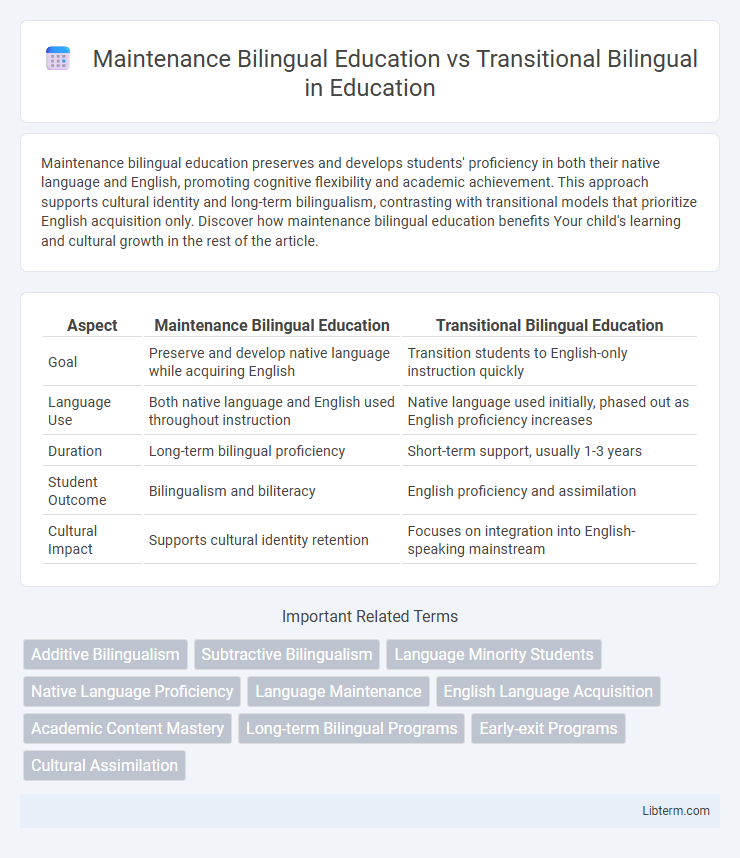Maintenance bilingual education preserves and develops students' proficiency in both their native language and English, promoting cognitive flexibility and academic achievement. This approach supports cultural identity and long-term bilingualism, contrasting with transitional models that prioritize English acquisition only. Discover how maintenance bilingual education benefits Your child's learning and cultural growth in the rest of the article.
Table of Comparison
| Aspect | Maintenance Bilingual Education | Transitional Bilingual Education |
|---|---|---|
| Goal | Preserve and develop native language while acquiring English | Transition students to English-only instruction quickly |
| Language Use | Both native language and English used throughout instruction | Native language used initially, phased out as English proficiency increases |
| Duration | Long-term bilingual proficiency | Short-term support, usually 1-3 years |
| Student Outcome | Bilingualism and biliteracy | English proficiency and assimilation |
| Cultural Impact | Supports cultural identity retention | Focuses on integration into English-speaking mainstream |
Overview of Bilingual Education Models
Maintenance Bilingual Education aims to develop and sustain proficiency in both the native language and English, promoting bilingualism and biliteracy over the long term. Transitional Bilingual Education focuses on quickly shifting students from their native language to English to facilitate integration into mainstream classrooms, often phasing out the first language. These models differ significantly in goals, language use duration, and cultural preservation emphasis within bilingual education frameworks.
Defining Maintenance Bilingual Education
Maintenance Bilingual Education is a program designed to develop and preserve students' native language while they simultaneously acquire proficiency in a second language, promoting bilingualism and biliteracy. It emphasizes the long-term development of both languages, contrasting with Transitional Bilingual Education, which aims primarily to shift students from their native language to English. This approach supports academic achievement and cultural identity by valuing students' linguistic backgrounds throughout their education.
Understanding Transitional Bilingual Education
Transitional Bilingual Education (TBE) aims to develop students' English proficiency while gradually transitioning them from their native language to English, typically concluding when students achieve academic success in English-only classrooms. This model contrasts with Maintenance Bilingual Education, which focuses on sustaining and developing both the native language and English literacy over time. Understanding TBE involves recognizing its primary goal of promoting English fluency quickly, often at the expense of native language preservation.
Key Objectives: Maintenance vs Transitional
Maintenance bilingual education aims to develop and sustain students' proficiency in both their native language and English, fostering bilingualism and biliteracy as long-term assets. Transitional bilingual education focuses on shifting students from their native language to English proficiency quickly, with the primary objective of English language acquisition for academic integration. While maintenance programs prioritize cultural preservation and cognitive benefits of bilingualism, transitional models emphasize English language mastery to facilitate mainstream classroom success.
Language Proficiency Outcomes
Maintenance bilingual education promotes long-term bilingualism by developing and sustaining proficiency in both the native and second languages, resulting in higher levels of fluency and literacy in both languages. Transitional bilingual education focuses on shifting students to English proficiency, often leading to limited retention of the native language and lower overall bilingual competence. Research indicates that students in maintenance programs exhibit stronger cognitive benefits, academic achievement, and cross-cultural communication skills compared to those in transitional programs.
Academic Achievement Comparisons
Maintenance bilingual education programs promote long-term proficiency in both the native language and English, resulting in higher academic achievement and cognitive benefits across subjects. Transitional bilingual education focuses on rapid English acquisition, often leading to limited native language development and mixed academic outcomes in content areas. Research shows that students in maintenance programs generally outperform their transitional peers on standardized tests and demonstrate stronger literacy and critical thinking skills.
Cultural Preservation and Identity
Maintenance bilingual education emphasizes the preservation of students' native language and cultural identity while promoting proficiency in a second language, fostering long-term bilingualism and biculturalism. Transitional bilingual education, designed to transition students to English proficiency, may inadvertently lead to cultural assimilation and reduced retention of the first language. Research indicates maintenance programs better support cultural preservation and a strong sense of identity among bilingual learners.
Program Structures and Implementation
Maintenance bilingual education emphasizes long-term bilingualism by developing literacy and academic skills in both the native language and English, utilizing a dual-language curriculum. Transitional bilingual education focuses on moving students from their native language to English proficiency as quickly as possible, often starting with native language instruction and gradually shifting to English-only instruction. Implementation of maintenance programs typically involves continuous native language support across subjects, while transitional programs reduce native language use over time until English dominates instruction.
Challenges and Criticisms
Maintenance bilingual education faces challenges such as limited funding, shortage of trained bilingual teachers, and potential social isolation of minority language students. Transitional bilingual programs are often criticized for promoting rapid English assimilation at the expense of native language proficiency, leading to language attrition and cultural loss. Both models struggle with balancing language development and academic achievement while addressing diverse community needs.
Choosing the Best Approach for Diverse Learners
Maintenance bilingual education preserves students' native language while they acquire English, promoting long-term bilingualism and cultural identity. Transitional bilingual education focuses on quickly shifting students to English-only instruction, aiming for rapid English proficiency but often risking loss of the native language. Choosing the best approach depends on learners' cultural background, academic goals, and community resources, with maintenance models benefiting diverse learners seeking bilingual competence and transitional models fitting contexts prioritizing swift English acquisition.
Maintenance Bilingual Education Infographic

 libterm.com
libterm.com